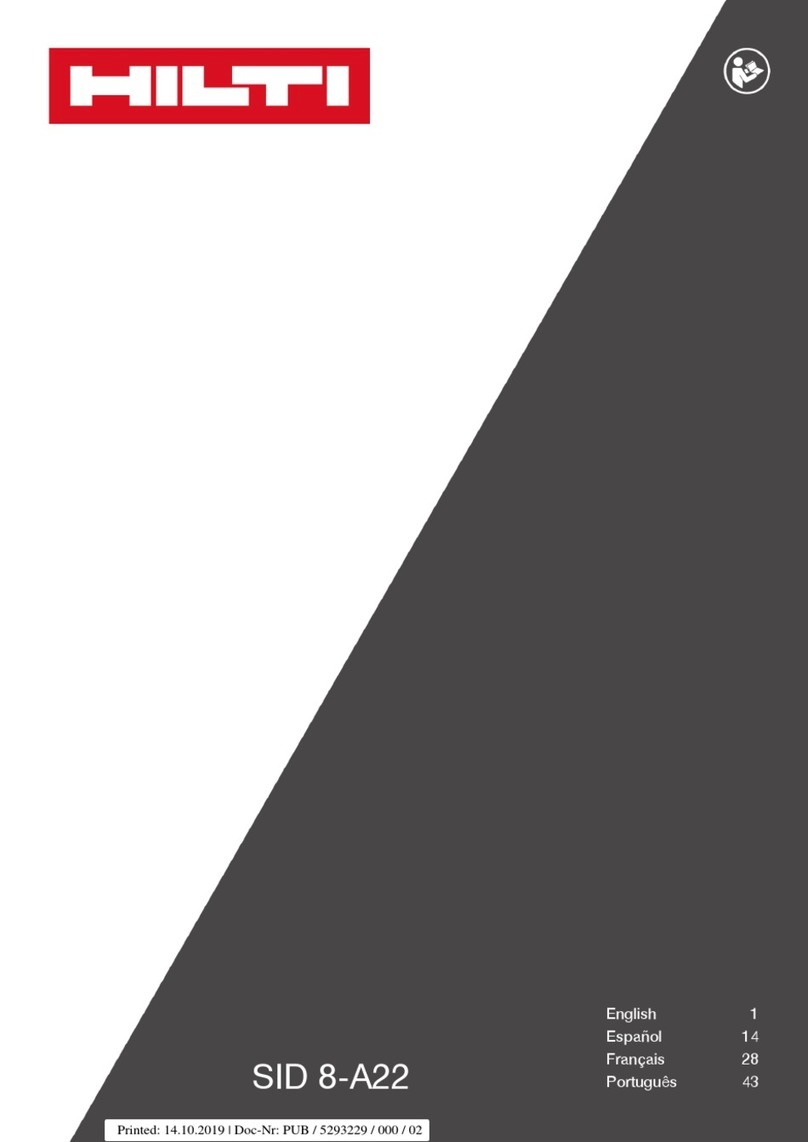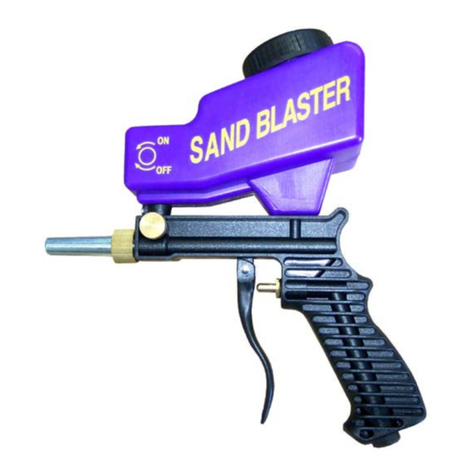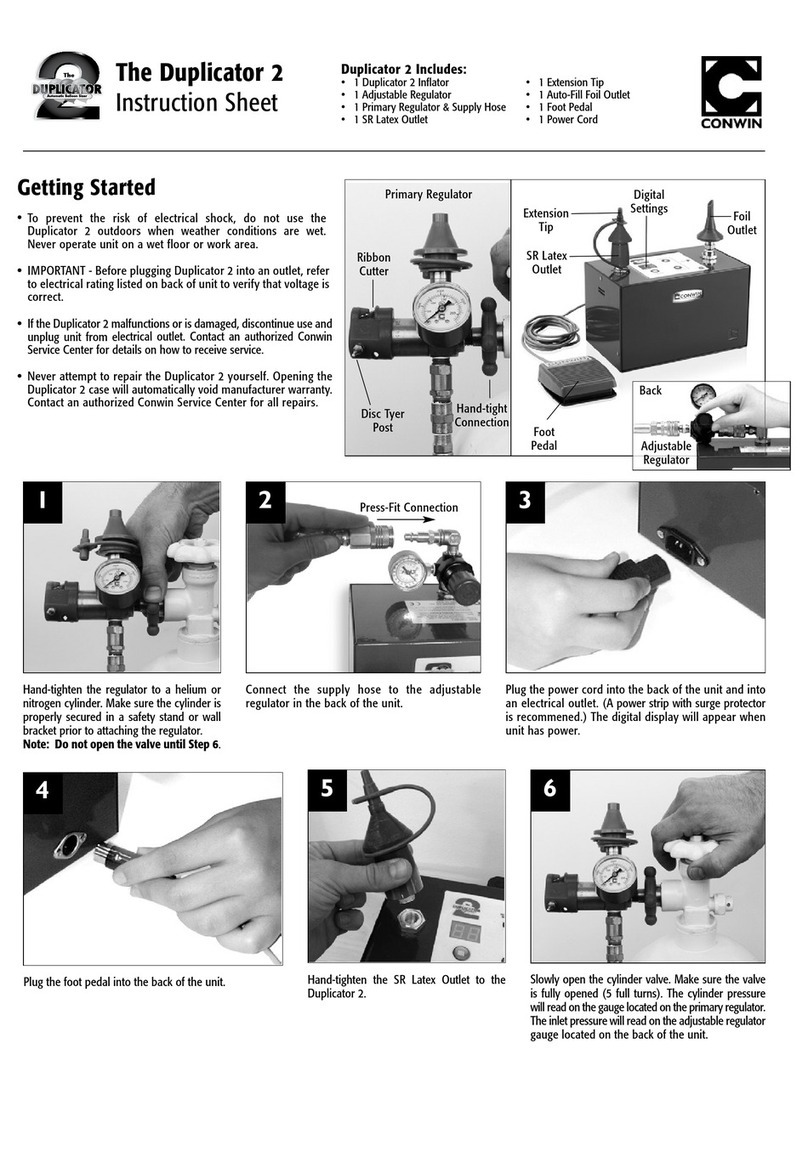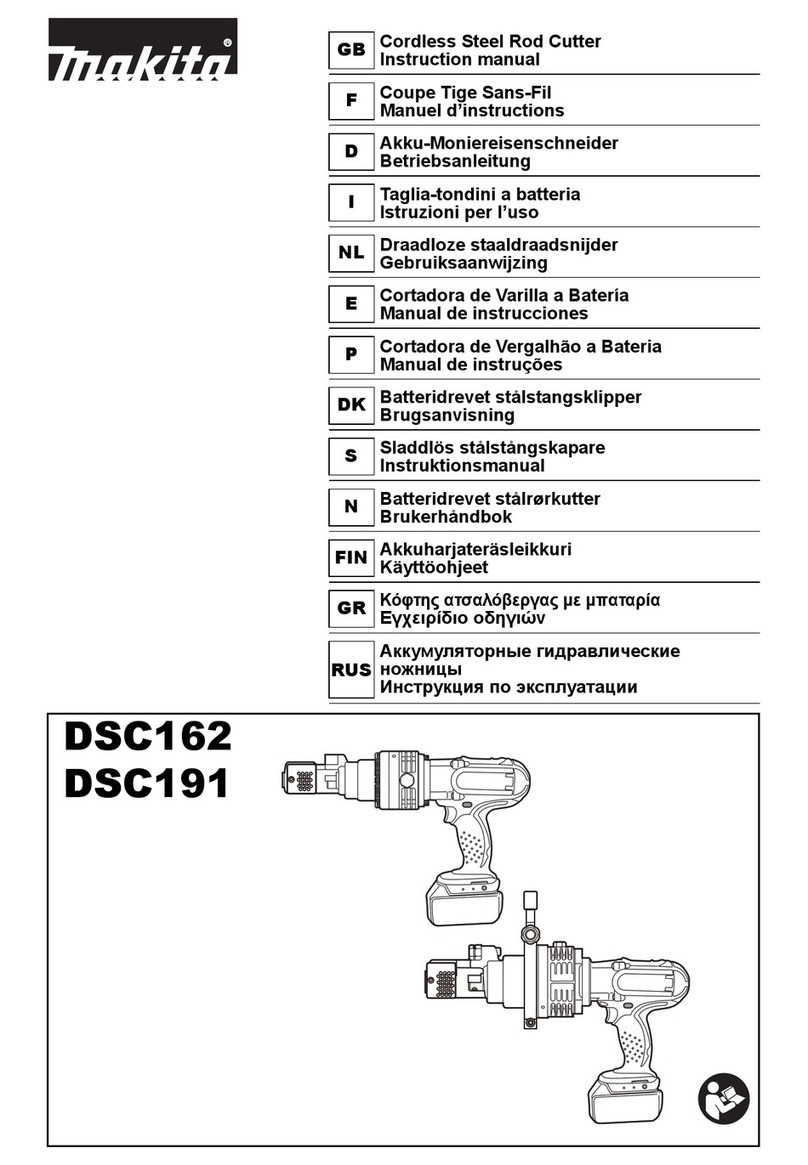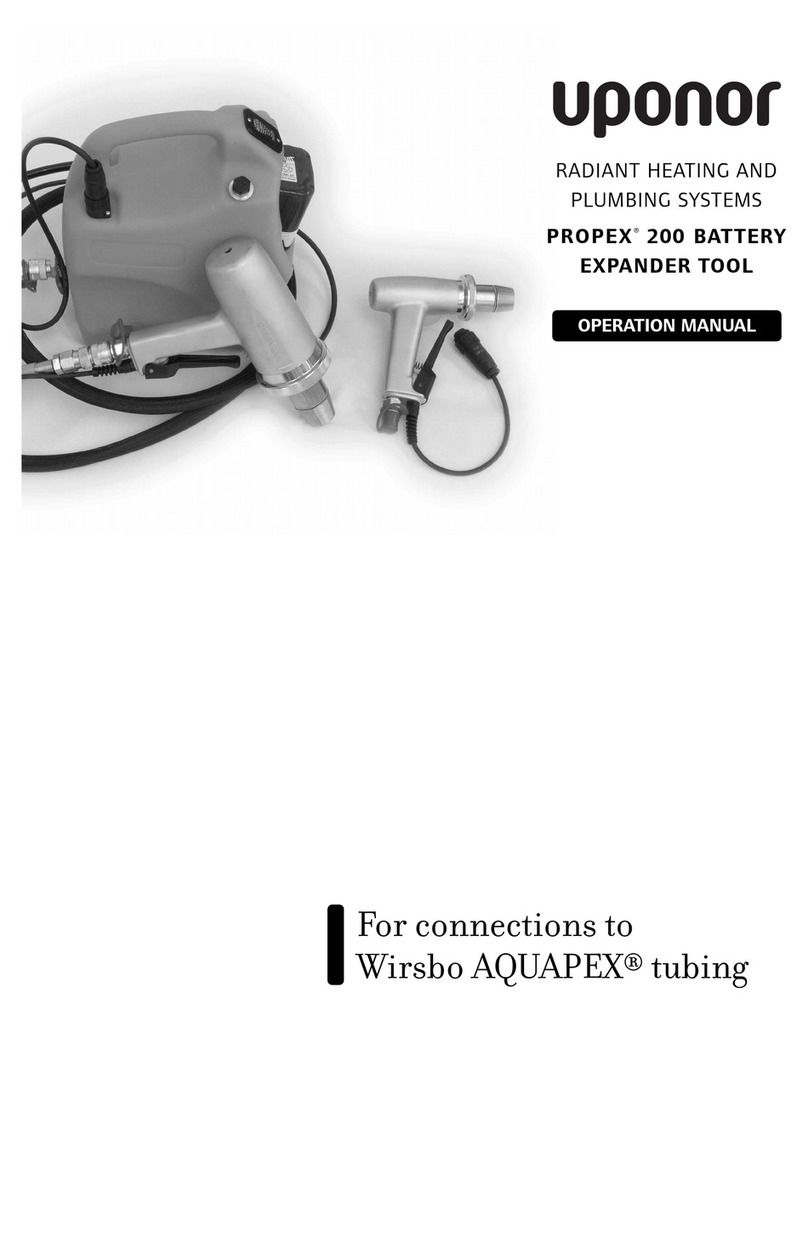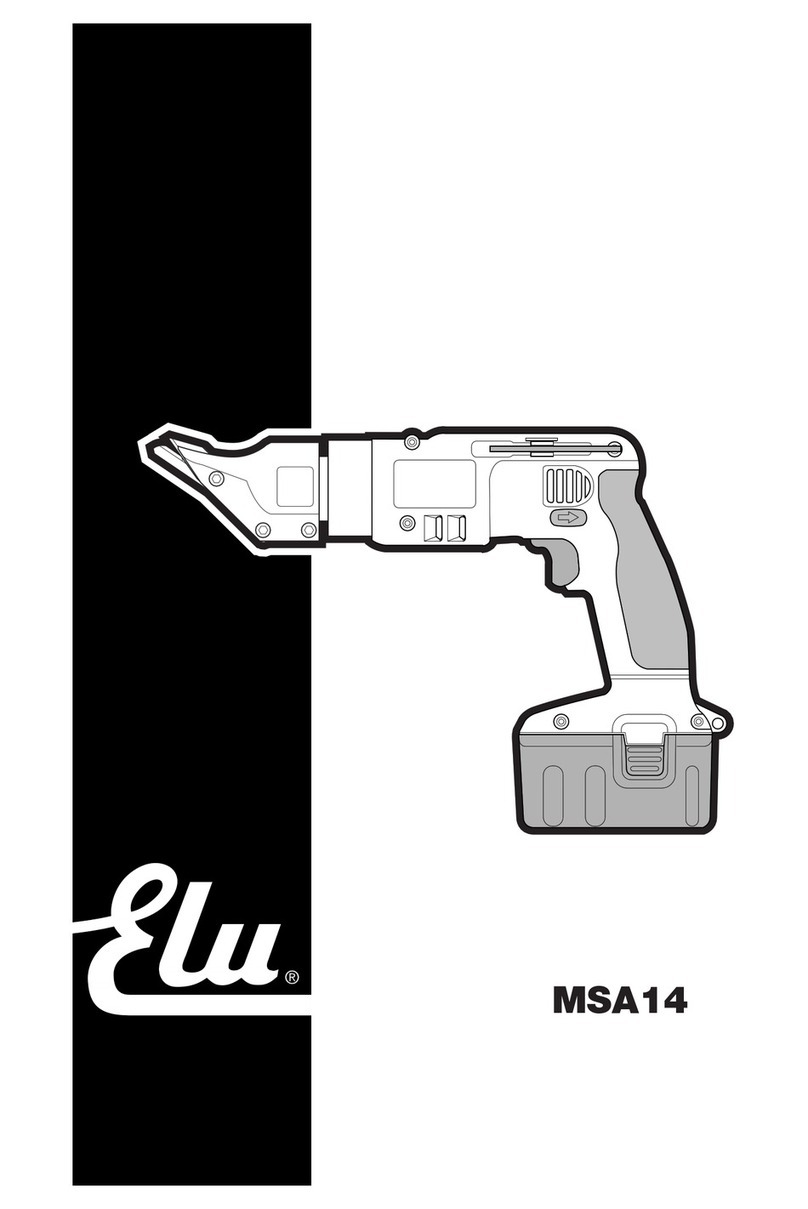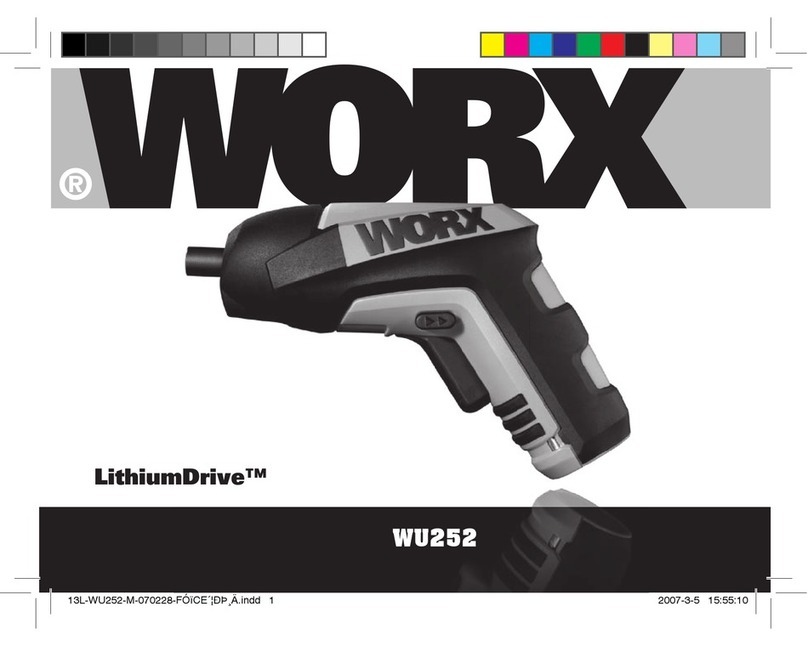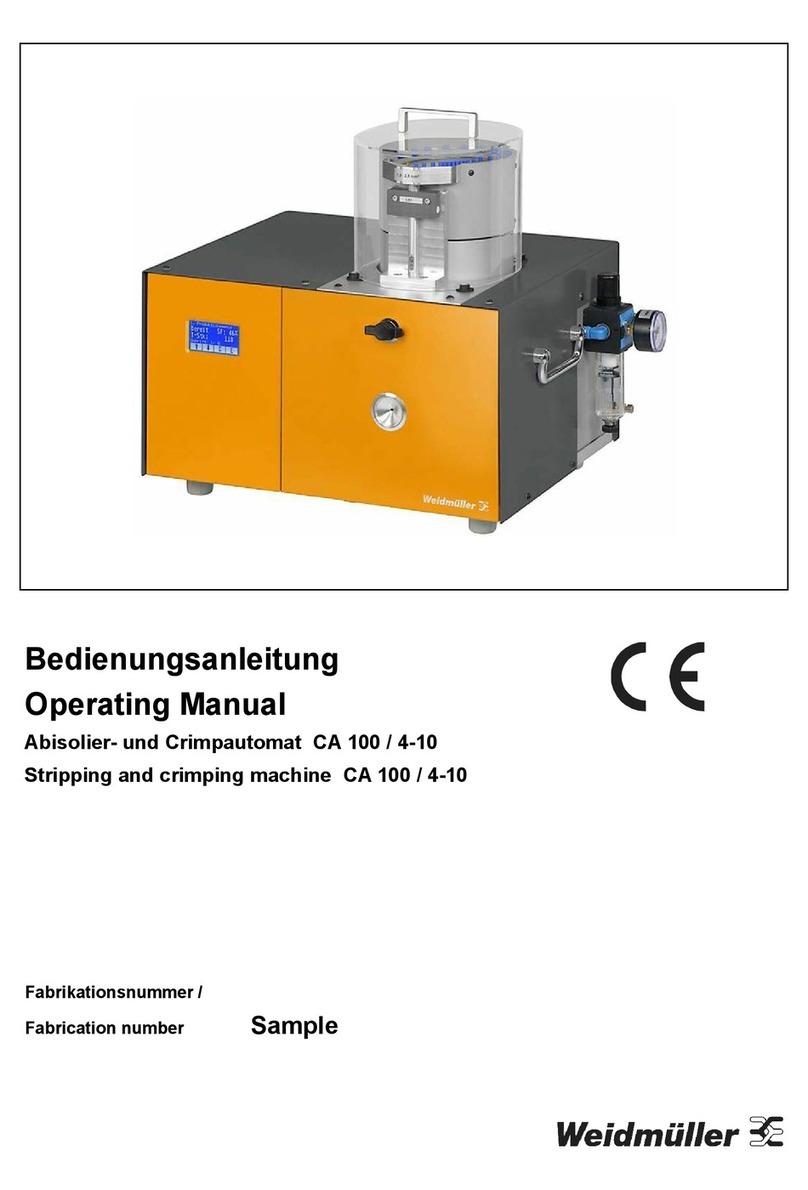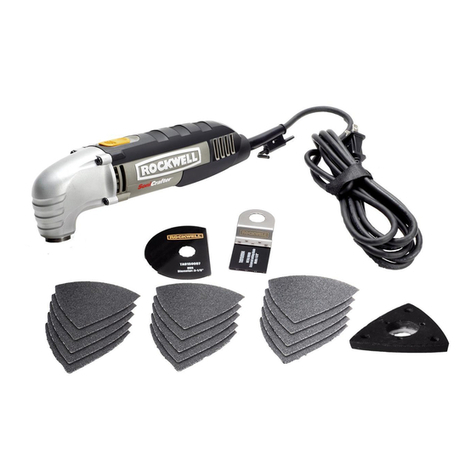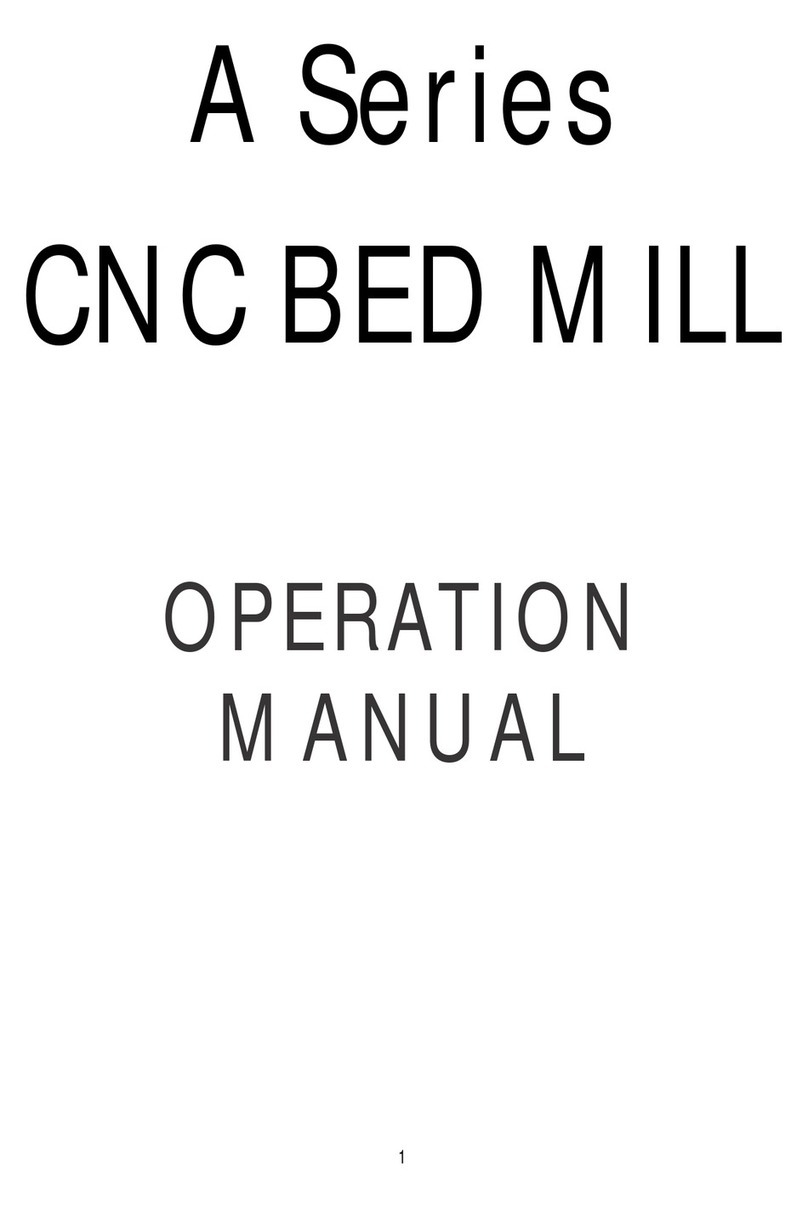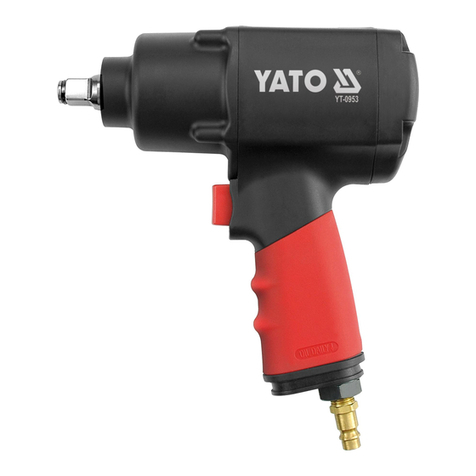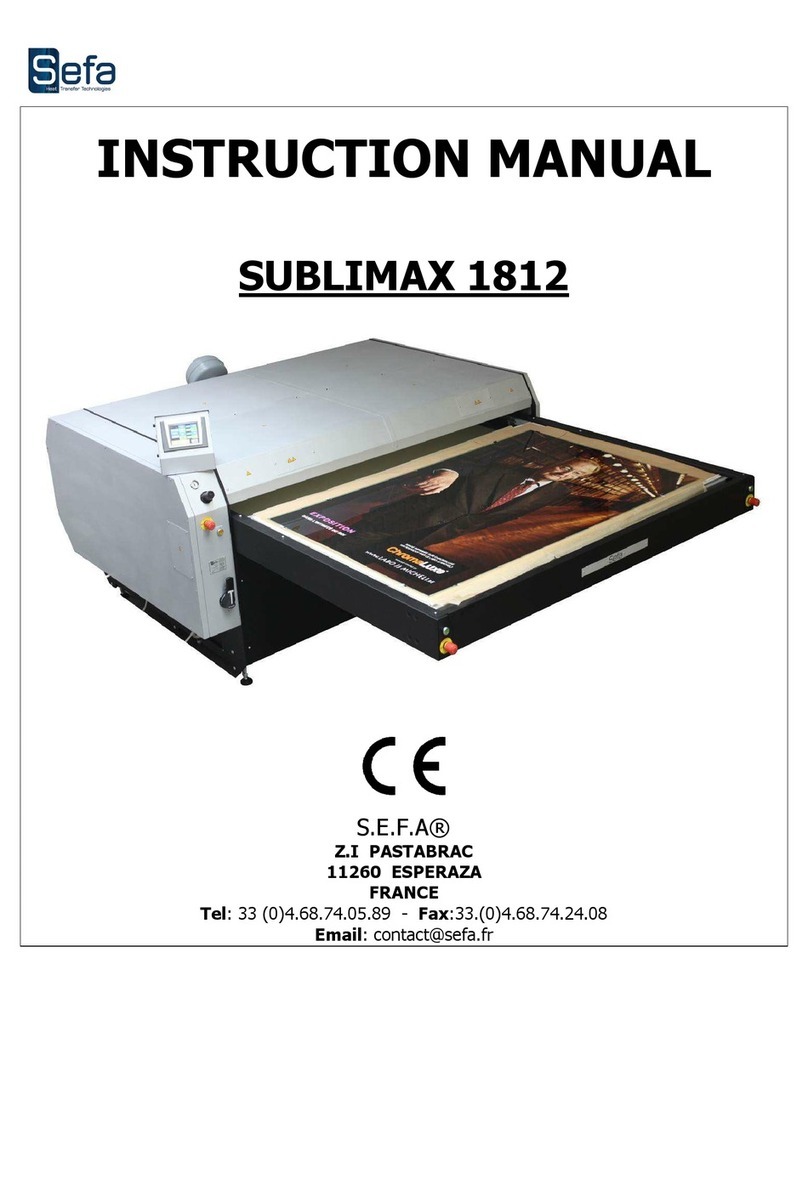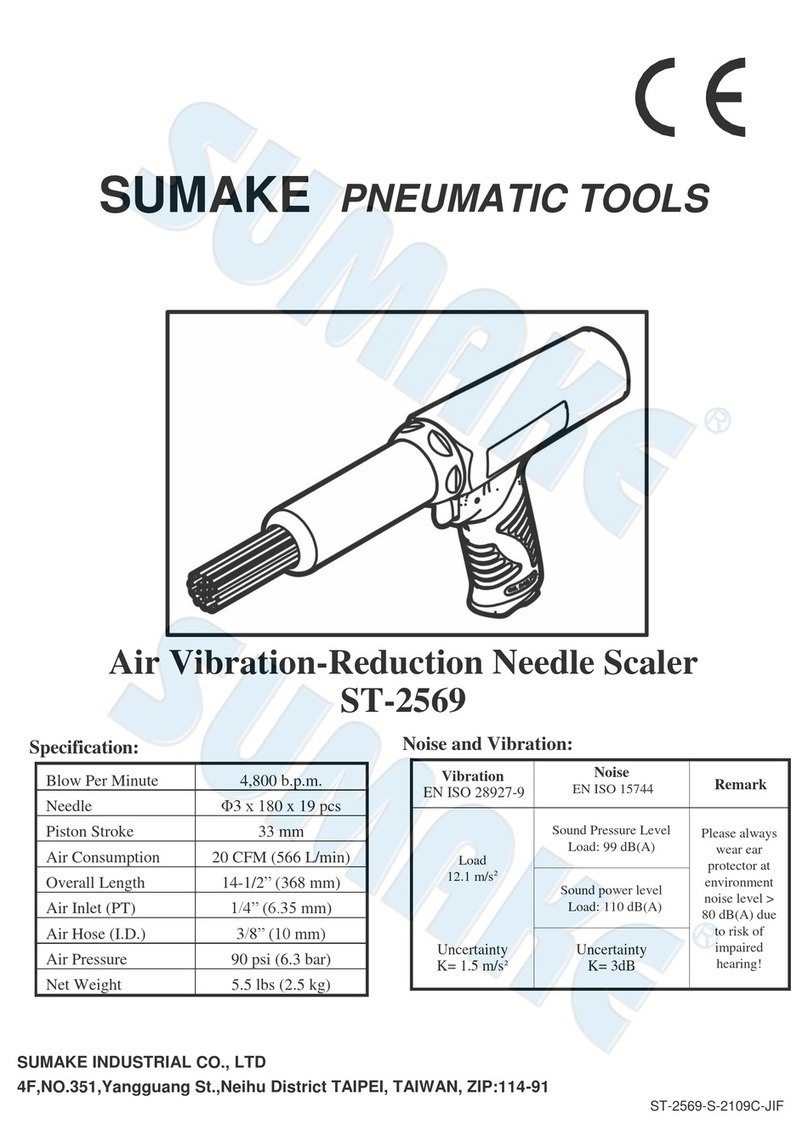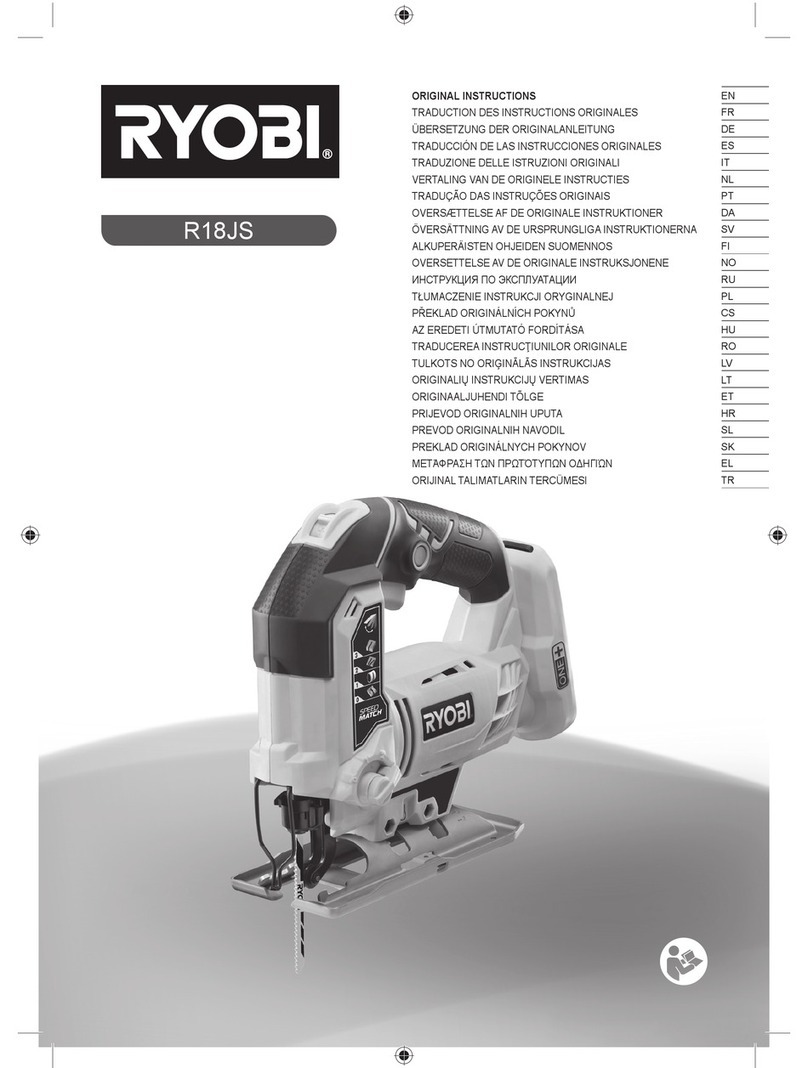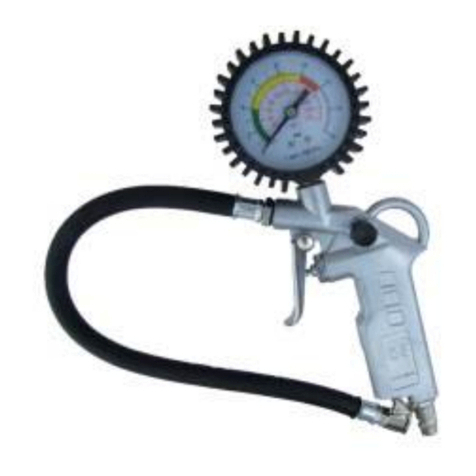Ferrida GS 9072 User manual

Cordless grass and shrub shears
GS 9072
User Manual


ENGLISH 4
DEUTSCH 14
ČESKY 25
SLOVENSKY 35
MAGYAR 45
WARRANTY & SUPPORT 56
GARANTIE & BETREUUNG 56
ZÁRUKA & PODPORA 56
ZÁRUKA & PODPORA 56
GARANCIA & TÁMOGATÁS 56

4ENGLISH
Important safety symbols and precautions:
In this manual and/or on the machine the following symbols are used and the precautions must be
followed:
Denotes risk of personal injury or dam-
age to the tool.
In accordance with essential require-
ments of the European directive(s)
Read manual before use Wear eye protection
Wear noise protection Wear gloves
Ambient temperature 40 °C max
(only for battery)
Do not expose charger and battery
pack to water
Use battery and charger only in closed
rooms
Do not incinerate battery pack or
charger
Danger! The blades run out when
switched off.
Danger of flying objects, keep your
distance.
This power tool produce a guaranteed
sound power level of 90 dB. Do not use the power tool in rain.
This power tool contains a Li-Ion batte-
ry. Recycle properly.
Do not dispose with normal domestic
waste.
Read all safety warnings and instructions. Failure to heed warnings and follow instructions may result
in electric shock, fire and/or serious injury. Keep safety warnings and instructions for future reference.
The term “power tool” in the safety warnings refers to your mains-operated (corded) power tool or
battery-operated (cordless) power tool.
Working area
• Keep working area clean and well lit. Untidy and dark areas can lead to accidents.
• Do not operate power tools in potentially explosive surroundings, for example, in the presence of
inflammable liquids, gases or dust. Power tools create sparks which may ignite the dust or fumes.
• Keep children and bystanders at adistance when operating apower tool. Distractions can cause
you to lose control of it.
Electrical safety
Always check that the power supply corresponds to the voltage on the rating plate of the char‑
ger.
• Always check that the power supply corresponds to the voltage on the rating plate.
• Power tool plugs must match the outlet. Never modify the plug in any way. Do not use adapter
SAFETY INFORMATION

5ENGLISH
plugs with earthed power tools. Unmodified plugs and matching outlets will reduce the risk of
alethal electric shock.
• Avoid body contact with earthed surfaces such as pipes, radiators, kitchen ranges and refrigera-
tors. There is an increased risk of alethal electric shock if your body is earthed.
• Do not expose power tools to rain or wet conditions. If water gets inside apower tool, it will incre-
ase the risk of alethal electric shock.
• Do not damage the cord. Never use the cord for carrying, pulling or unplugging the power tool.
Keep the cord away from heat, oil, sharp edges or moving parts. Damaged or entangled cords
increase the risk of alethal electric shock.
• When operating apower tool outdoors, use an extension cable suitable for outdoor use. Using
acord suitable for outdoor use reduces the risk of alethal electric shock.
• If operating apower tool in adamp location is unavoidable, use apower supply protected by
aresidual current device (RCD). Using an RCD reduces the risk of alethal electric shock.
Personal safety
• Stay alert, watch what you are doing and use common sense when operating apower tool. Do
not use apower tool when you are tired or under the influence of drugs, alcohol or medication.
Amoment of inattention when operating apower tool may result in serious personal injury.
• Use safety equipment. Always wear eye protection. Using safety equipment such as adust mask,
non-skid safety shoes, ahard hat, or hearing protection whenever it is needed will reduce the risk
of personal injury.
• Avoid accidental starts. Ensure the switch is in the off position before inserting the plug. Carrying
power tools with your finger on the switch or plugging in power tools when the switch is in the on
position makes accidents more likely.
• Remove any adjusting keys or spanners before turning on the power tool. Aspanner or key left
attached to arotating part of the power tool may result in personal injury.
• Do not reach out too far. Keep your feet firmly on the ground at all times. This will enable you
retain control over the power tool in unexpected situations.
• Dress properly. Do not wear loose clothing or jewellery. Keep your hair, clothing and gloves away
from the power tool. Loose clothes, jewellery or long hair can become entangled in the moving
parts.
• If there are devices for connecting dust extraction and collection facilities, please ensure that they
are attached and used correctly. Using such devices can reduce dust-related hazards.
Power tool use and care
• Do not expect the power tool to do more than it can. Use the correct power tool for what you
want to do. Apower tool will achieve better results and be safer if used in the context for which
it was designed.
• Do not use the power tool if the switch cannot turn it on and off. Apower tool with abroken switch
is dangerous and must be repaired.
• Disconnect the plug from the power source before making adjustments, changing accessories,
or storing power tools. Such preventive safety measures reduce the risk of starting the power tool
accidentally.
• Store power tools, when not in use, out of the reach of children and do not allow people who
are not familiar with the power tool or these instructions to operate it. Power tools are potentially
dangerous in the hands of untrained users.
• Maintenance. Check for misalignment or jammed moving parts, breakages or any other feature
that might affect the operation of the power tool. If it is damaged, the power tool must be repai-
red. Many accidents are caused by using poorly maintained power tools.
• Keep cutting tools sharp and clean. Properly maintained cutting tools with sharp cutting edges
are less likely to jam and are easier to control.
SAFETY INFORMATION

6ENGLISH
• Use the power tool, accessories and cutting tools, etc., in accordance with these instructions and
in the manner intended for the particular type of power tool, taking into account the working
conditions and the work which needs to be done. Using apower tool in ways for which it was not
intended can lead to potentially hazardous situations.
Service
• Your power tool should be serviced by aqualified specialist using only standard spare parts. This
will ensure that it meets the required safety standards.
SPECIAL SAFETY REGULATIONS FOR CORDLESS GRASS/HEDGE SHEARS
Shrub shears safety warning
• Keep all parts of the body away from the cutter blade. Do not remove cut material or hold mate-
rial to be cut when blades are moving.
• Make sure the switch is off when clearing jammed material. Amoment of inattention while opera-
ting the machine may result in serious personal injury.
• Carry the machine by the handle with the cutter blade stopped. When transporting or storing the
machine always fit the cutting device cover. Proper handling of the machine will reduce possible
personal injury from the cutter blades.
• Keep cables away from cutting area. During operation the cable may be hidden in shrubs and can
be accidentally cut by the blade.
Grass shears safety warning
• Keep supply and extension cords away from cutting means.
• Use the machine only in daylight or good artificial light.
• Never operate the machine with damaged guards or shields or without guards or shields in place.
• Switch on the motor only when the hands and feet are away from the cutting means.
• Always disconnect the machine from the power supply (i. e. remove the plug from the mains or
remove the disabling device):
– whenever leaving the machine unattended
– before clearing ablockage
– before checking, cleaning or working on the unit
– after striking aforeign object
– whenever the machine starts vibrating abnormally
• Take care against injury to feet and hands from the cutting means.
• Always ensure that the ventilation openings are kept clear of debris.
Battery/Battery charger safety warnings
• Protect the battery charger from rain and moisture. The penetration of water in abattery charger
increases the risk of electric shock.
• Recharge only with the charger specified by the manufacturer. Acharger that is suitable for one
type of battery pack may create arisk of fire when used with another battery pack.
• Keep the battery charger clean. Contamination may cause the danger of electric shock.
• Check the battery charger, cable and plug each time before using. Do not use the battery charger
when defects are detected. Do not open the battery charger yourself and have it repaired only
by qualified personnel using original spare parts. Damaged battery chargers, cables and plugs
increase the risk of electric shock.
• Do not operate the battery charger on easily inflammable surfaces (e. g. paper, textiles, etc.) or
in combustible environments. There is danger of fire due to the heating of the battery charger
during charging.
SAFETY INFORMATION

7ENGLISH
SAFETY INFORMATION
• Under abusive conditions, liquid may be ejected from the battery; avoid contact. If contact ac-
cidentally occurs, flush with water. If liquid contacts eyes, additionally seek medical help. Liquid
ejected from the battery may cause irritation or bums.
• Do not open the battery yourself. There is danger of ashort circuit.
• Protect the battery against heat, e.g., including against continuous sun irradiation and fire. There
is adanger of explosion.
• Do not short-circuit the battery. There is adanger of explosion.
• In case of damage and improper use of the battery, vapours may be emitted. In case of com-
plaints, provide for fresh air and consult aphysician. The vapours can irritate the respiratory sys-
tem.

8ENGLISH
OVERVIEW
TECHNICAL DATA
Battery type Li-Ion
Battery voltage 7.2 V
Battery capacity 1500 mAh
Charging time (empty battery) 3-5h
Running time max. 40 min
Cutting width of the grass cutter 90 mm
Cutting width of the shrub shears 170 mm
Cutting thickness of the shrub shears 8 mm
7
3
4
5
6
2
12
1
8
4
3
12
1
3
12
4
11
1 Grass cutter blade
2 Wheels
3 Safety lock‑off
4 ON button
5 Telescopic long handle
6 Clamp coupling for telescopic long handle
7 Handle cap
8 Machine bracket
9 Blade guard
10 Battery charger
11 Shrub cutter blade
12 Blade release mechanism

9ENGLISH
8
22
1
A
A1
8
A
22
A
A
2 3
4 5
6 7
OPERATION

10 ENGLISH
A1
8
A
22
A
A
8 9
10 11
12
OPERATION

11ENGLISH
Charging procedure
• Connect the charger to the charging station (Fig. 2).
• Check that your mains voltage is the same as that marked on the rating plate of the battery char-
ger. Plug the battery charger in asocket-outlet. The red LED (Fig. 2 / Item 1) comes on to indicate
that charging voltage is available.
• The battery pack is being charged. An empty battery pack requires amaximum charging period
of 3~5 hours. The temperature of the battery pack may rise slightly during the charging operati-
on. This is normal.
• As soon as battery pack is fully charged, the red LED (Fig. 2/Item 1) extinguishes
Notes on charging:
• If the rechargeable battery fails to charge, check whether there is voltage at the socket outlet.
• Timely recharging of the battery pack will help it serve you well for along time. Recharging is
always necessary when you notice adrop in the tool’sperformance.
• Never allow the battery pack to become fully discharged. This will cause it to develop adefect.
Fitting the long handle
Using the telescopic long handle (Fig. 1/Item 5) you can push the cordless shears on wheels over
the lawn. The long handle is only for use with the grass cutter blade and must not be used with the
hedge cutter blade!
• To attach the long handle, push the fitting (Fig. 3/ Item 8) onto the tool in the direction of the
arrow until the catch clicks into position.
• Now mount the wheels (Fig. 4/Item 2) on the axle and push inwards.
• Unscrew the fitting (Fig. 1/Item 6), adjust the telescopic handle to the required length and then
tighten the fitting again. Press the catch in and push the tool onto the telescopic handle as shown
by the direction of the arrow in Fig. 5. After letting go of the catch, make sure that the fitting is
correctly engaged (Fig. 1/Item 8).Then connect the power plug Fig. 6 to the tool as shown in (Fig.
7/Item A). Press the catch (Fig. 8/Item A) to rotate the tool to the left or right and to use it as an
edge trimmer. Make sure that it clicks into place!
• To take apart, proceed in the reverse order. To remove the fitting (Fig. 9/Item 8), push it in the
direction of the arrow (Fig. 9/Item A).
Important!
It is prohibited to remove or bridge any of the switching elements installed on the tool by the ma-
nufacturer (e.g. by securing abutton to the handle) as this would prevent the tool from switching off
automatically and result in high risk of injury.
Under no circumstances are you to use the shrub cutter with the telescopic long handle fitted.
Using the device
The area to be cut must first be cleared of stones and other solid objects. The safety lock-off (Fig. 1/
Item 3) prevents the tool being started unintentionally. Activate the safety lock-off (Fig. 1 / Item 3) by
pushing it forward and pressing the ON/ OFF switch (Fig. 1 /Item 4) at the same time. To switch off the
tool, let go of the ON/OFF switch (Fig. 1 / Item 4).
Cutting grass
Allow the grass cutter to glide above the ground. The best results are achieved when the lawn is dry.
When you notice adrop in cutting performance, re-charge the tool immediately so that the battery
does not become fully discharged.
Trimming hedges
The tool can be used to trim small hedges and shrubs.
OPERATION

12 ENGLISH
Hold the tool slightly tilted in relation to the hedge you want to cut. First cut the sides from the bo-
ttom up, then cut the top. Watch out for foreign objects in or on the hedge which could damage the
blades.
When is the best time to trim hedges?
• As ageneral rule, hedges which lose their leaves in the autumn should be trimmed in June and
October.
• Hedges which do not lose their leaves should be cut in April and August.
Changing the blades
To remove the blade, press the release mechanism (Fig. 1/Item 12) and move down the blade as
shown in Fig. 10/Item 11. Once you have removed the blade you will be able to see the toothed
wheels of the gear unit (Fig. 11). Make sure that no dirt gets into the gear unit when you change the
blade. To assemble, proceed in the reverse order.
Adjusting the handle angle
• To push inside the rotation button then rotate the machine handle (Fig. 12).
• There have 3 position between handle and housing.
• When you chosen the position what you want, then release the rotation button.
OPERATION

13ENGLISH
To ensure long and reliable service, carry out the following maintenance regularly.
• Check for obvious defects such as loose, dislodged or damaged blade, loose fixings and worn
or damaged components.
• Check that covers and guards are undamaged and correctly fitted. Carry out necessary mainte-
nance or repairs before using.
• If the machine should happen to fail despite the care taken in manufacturing and testing, repair
should be carried out by our technical department.
Blade maintenance
• Always clean the cutting blades after operation and lubricate with oil.
• During longer cutting jobs, we recommend periodically lubricating the cutting blade.
• Visually check the condition of the cutting edges of the cutting blade.
• Ensure that the blade is covered with the blade guard supplied when not in use.
Cleaning/storage
• Clean the exterior of the machine thoroughly using asoft brush and cloth. Do not use water,
solvents or polishes. Remove all debris, especially from the ventilation slots. Store the machine
in asecure dry place out of reach of children. Do not place other objects on top of the machine.
Service department
• Damaged switches must be replaced by our after-sales service department.
• If the connecting cable (or mains plug) is damaged, it must be replaced by aparticular connec-
ting cable which is available from our service department. Replacement of the connecting cable
must only be carried out by our service department (see last page) or by aqualified person
(qualified electrician).
Storage
• Ensure battery is removed before storage.
• Battery should be stored between 0 & 45 °C, incorrect storage could result in battery damage.
• Thoroughly clean the whole machine and its accessories.
• Store it out of the reach of children, in astable and secure position, in acool and dry place, avoid
too high and too low temperatures.
• Protect it from exposure to direct sunlight. Keep it in the dark, if possible.
• Don’t keep it in plastic bags to avoid humidity build-up.
MAINTENANCE AND STORAGE

14 ENGLISH
Identification of the manufacturer / importer’sauthorised representative:
Importer: Alza.cz,a.s.
Registered office: Jankovcova 1522/53, Holešovice, 170 00 Prague 7
Company ID: 27082440
Subject of the declaration:
Name: Cordless grass and shrub shears
Model/Type: GS 9072 / M1E-7.2LD-170M/G-1
The above product has been tested in accordance with the standards used to demonstrate
compliance with the essential requirements laid down in the Directive(s):
Directive 2006/42/EU
Directive 2014/30/EU
Directive 2000/14/EC as amended by 2005/88/EC
Directive 2011 /65/EU as amended by 2015/863/EU
EN 60745-1:2009/A11:2010
EN 60745-2-15:2009/A1:2010
EN 60335-1:2012/A13:2017
EN 50636-2-94:2014
EN 62233:2008
EN 55014-1:2017
EN 55014-2:2015
EN IEC61000-3-2:2019
EN 61000-3-3:2013/A1:2019
Compliance assessment procedures:
2000/14/EC ‑ Annex V
Measured sound power level LWA 87 dB
Guaranteed sound power level LWA 90 dB
Vibrations 2,7 m/s2; K=1,4 m/s2
In Prague on 27.1.2021
EC DECLARATION OF CONFORMITY

15DEUTSCH
Wichtige Sicherheitssymbole und Sicherheitsvorkehrungen:
In diesem Handbuch und/oder auf dem Gerät sind folgende Symbole angeführt.Auch die folgenden
Sicherheitsvorkehrungen sind einzuhalten:
Hierdurch werden das Verletzungsri-
siko von Personen oder eine mögli-
che Beschädigung des Werkzeugs
bezeichnet.
Im Einklang mit den grundlegenden
Anforderungen europäischer Richtli-
nien
Lesen Sie vor dem Gebrauch die
Bedienungsanleitung durch Tragen Sie Augenschutz
Benutzen Sie Lärmschutz Benutzen Sie Handschuhe
Betriebstemperatur max. 40 °C
(gilt für den Akku)
Ladegerät oder Akku niemals Wasser
aussetzen
Benutzen Sie den Akku und das Lade-
gerät nur in geschlossenen Räumen
Ladegerät oder AKku niemals Feuer
aussetzen
Achtung! Die Klingen gehen beim
Ausschalten aus.
Gefahr von Flugobjekten, Abstand
halten.
Dieses Elektrowerkzeug erzeugt einen
garantierten Schallleistungspegel von
90 dB.
Verwenden Sie das Elektrowerkzeug
nicht bei Regen.
Dieses Elektrowerkzeug enthält einen
Li-Ion-Akku. Richtig recyceln.
Nicht mit normalem Hausmüll entsor-
gen.
Lesen alle Sicherheits- und Warnhinweise durch. Die Nichteinhaltung der Sicherheits- und Warnhin-
weise kann zu Stromschlag, Brand und/oder einer schweren Verletzung führen. Bewahren Sie die Si-
cherheits- und Warnhinweise für den künftigen Gebrauch gut auf. Der Begriff „Elektrowerkzeug“ wird
in den Sicherheitshinweisen als ein Elektrowerkzeug bezeichnet, das mit einem Stromkabel oder
einem Akku (kabellos) versorgt wird.
Arbeitsbereich
• Halten Sie den Arbeitsbereich sauber und gut beleuchtet. Nicht saubere und dunkle Räume kön-
nen zu Verletzungen führen.
• Betreiben Sie das Elektrowerkzeug nicht in einer Umgebung mit Explosionsgefahr, zum Beispiel
in der Anwesenheit von brennbaren Flüssigkeiten, Gasen oder Staub. Das Elektrowerkzeug er-
zeugt Funken, die Staub oder Dämpfe entzünden können.
• Geben Sie Acht, damit Kinder und herumstehende Personen einen ausreichenden Abstand ein-
halten, wenn Sie mit dem Elektrogerät arbeiten. Falls Sie abgelenkt werden, können Sie die Kon-
trolle über dem Elektrowerkzeug verlieren.
SICHERHEITSHINWEISE

16 DEUTSCH
Elektrische Sicherheit
Vergewissern Sie sich jedes Mal, dass die Stromversorgung mit der auf dem Adapter- oder
dem Ladegerätschild angeführten Spannung übereinstimmt.
• Vergewissern Sie sich jedes Mal, dass die Stromversorgung mit der auf dem Geräteschild ange-
führten Spannung übereinstimmt.
• Die Stecker der Elektrowerkzeuge müssen mit der Steckdose übereinstimmen. Führen Sie keine
Änderungen am Stecker durch. Benutzen Sie keine Adapter mit einem geerdeten Elektrowerk-
zeug. Stecker, an denen keine Eingriffe vorgenommen wurden, und entsprechende Steckdosen
reduzieren Stromunfälle mit Todesfolge.
• Vermeiden Sie Kontakt zwischen Körper und geerdeten Oberflächen wie Röhren, Heizkörpern,
Küchenzeilen und Kühlschränken. Es besteht ein erhöhtes Risiko eines Stromunfälles mit Todes-
folge, falls Ihr Körper geerdet wurde.
• Setzen Sie das Elektrowerkzeug weder Regen noch Feuchtigkeit aus. Sollte Wasser in das Elektro-
werkzeug gelangen, erhöht dies das Risiko eines Stromunfalles mit Todesfolge.
• Beschädigen Sie nicht das Kabel. Benutzen Sie niemals das Kabel zum Transportieren, Ziehen
oder Trennen des Elektrowerkzeugs vom Stromnetz. Halten Sie das Kabel außer Reichweite von
Wärme, Öl, scharfen Kanten oder beweglichen Teilen. Beschädigte oder verhedderte Kabel er-
höhen das Risiko eines Stromunfalles mit Todesfolge.
• Falls Sie mit dem Elektrowerkzeug draußen arbeiten, benutzen Sie ein Verlängerungskabel, das
für den Außengebrauch geeignet ist. Falls Sie ein Kabel benutzen, das für den Außengebrauch
bestimmt ist, reduzieren Sie hierdurch das Risiko eines Stromunfalles mit Todesfolge.
• Sollte der Betrieb des Elektrowerkzeugs an einem feuchten Ort unvermeidlich sein, benutzen Sie
eine Stromversorgung, die mit Stromschutz (RCD) geschützt ist. Falls Sie einen Stromschutz (RCD)
benutzen, reduzieren Sie hierdurch das Risiko eines Stromunfalles mit Todesfolge.
Persönliche Sicherheit
• Seien Sie aufmerksam, kontrollieren Sie Ihre Bewegungen und benutzen Sie bei der Verwendung
des Elektrowerkzeugs gesunden Menschenverstand. Benutzen Sie das Elektrowerkzeug nicht,
falls Sie müde oder unter Einfluss von Drogen, Alkohol oder Medikamenten stehen. Ein kurzer
Augenblick der Unachtsamkeit bei der Bedienung des Elektrowerkzeugs kann zu schweren Ver-
letzungen führen.
• Benutzen Sie Sicherheitsausrüstung. Tragen Sie stets Augenschutz. Benutzen Sie Sicherheitsaus-
rüstung wie Staubmasken, rutschfestes Sicherheitsschuhwerk, ein fester Hut oder Gehörschutz,
um das Risiko von Verletzungen von Personen zu reduzieren.
• Vermeiden Sie eine versehentliche Inbetriebnahme. Vergewissern Sie sich, ehe Sie den Stecker
in die Steckdose stecken, dass der Schalter in Position AUS ist. Das Tragen des Elektrowerkzeugs
mit dem Finger auf dem Hauptschalter oder das Anschließen des Elektrowerkzeugs mit einge-
schaltetem Hauptschalter, erhöht die Wahrscheinlichkeit eines Unfalls.
• Ehe Sie das Elektrowerkzeug einschalten, entfernen Sie die Einrichtungsschüssel. Der Schlüssel,
der am rotierenden Teil des Elektrowerkzeugs befestigt ist, kann zu Verletzungen von Personen
führen.
• Versuchen Sie nicht mit dem Elektrowerkzeug allzu weit zu gelangen. Sorgen Sie dafür, dass Ihre
Füße unter allen Umständen stabil stehen. Auf diese Weise bewahren Sie die Kontrolle über dem
Elektrowerkzeug in unerwarteten Situationen.
• Achten Sie auf passende Kleidung. Tragen Sie weder lose Kleidung noch Schmuck. Halten
Sie Haare, Kleidung und Handschuhe außer Reichweite des Elektrowerkzeugs. Lose Kleidung,
Schmuck oder lange Haare können sich in den beweglichen Teilen einfangen.
• Sollten Sie zur Verfügung zusätzliche Geräte zum Absaugen oder Sammeln von Staub haben, ver-
gewissern Sie sich, dass diese angeschlossen sind und richtig benutzt werden. Die Anwendung
solcher Geräte kann Gefahren im Zusammenhang mit Staub eliminieren.
SICHERHEITSHINWEISE

17DEUTSCH
Bedienung und Wartung von Elektrowerkzeugen
• Erwarten Sie nicht, dass das Elektrowerkzeug Arbeiten über seine Anwendungsmöglichkeiten hi-
naus ausübt. Benutzen Sie stetes das passende Elektrowerkzeug für den jeweiligen Zweck. Elek-
trowerkzeuge arbeiten besser und zuverlässigerer, falls Sie für den vorgesehenen Zweck benutzt
werden.
• Benutzen Sie das Elektrowerkzeug nicht, falls es nicht ein- oder ausgeschaltet werden kann. Ein
Elektrowerkzeug mit einem defekten Hauptschalter ist gefährlich und muss repariert werden.
• Ziehen Sie den Stecker heraus, falls Sie Änderungen am Elektrowerkzeug durchführen, das Zu-
behör auswechseln oder das Elektrowerkzeug ablegen möchten. Diese vorbeugenden Sicher-
heitsvorkehrungen reduzieren das Risiko einer versehentlichen Inbetriebnahme des Elektro-
werkzeugs.
• Falls Sie das Elektrowerkzeug nicht benutzen, legen Sie es außer Reichweite von Kindern ab und
geben Sie Acht, damit das Elektrowerkzeug nicht von Personen bedient wird, die weder mit dem
Elektrowerkzeug noch diesen Hinweisen bekannt gemacht wurden. Das Elektrowerkzeug könnte
in den Händen von unerfahrenen Anwendern gefährlich sein.
• Achten Sie auf eine richtige Wartung. Überprüfen Sie, ob die beweglichen Teile nicht falsch aus-
gerichtet, stecken geblieben oder gebrochen sind. Auch sollten Sie andere Vorfälle prüfen, die
Einfluss auf den Betrieb des Elektrowerkzeugs haben können. Falls das Elektrowerkzeug beschä-
digt ist, muss es repariert werden. Viele Unfälle sind auf die Anwendung eines falsch gewarteten
Elektrowerkzeugs zurückzuführen.
• Halten Sie die Schneidewerkzeuge scharf und sauber. Gut gewartete Schneidewerkzeuge mit
scharfen Kanten bleiben nicht so oft stecken und sind einfacher zu bedienen.
• Benutzen Sie das Elektrowerkzeug, das Zubehör und Schneidwerkzeuge im Einklang mit diesen
Hinweisen und auf eine Art und Weise, die für den konkreten Typ des Elektrowerkzeugs bestimmt
ist, wobei Arbeitsbedingungen und die zu ausübende Arbeit zu berücksichtigen sind. Die An-
wendung des Elektrowerkzeugs auf eine Art und Weise, für das es nicht bestimmt ist, kann zu
gefährlichen Situationen führen.
Service
• Das Elektrowerkzeug sollte ausschließlich durch einen qualifizierten Fachmann gewartet werden,
der ausschließlich standardisierte Ersatzteile benutzt. Nur so kann sichergestellt werden, dass das
Werkzeug die gewünschten Sicherheitsstandards erfüllt.
BESONDER SICHERHEITSVORKEHRUNGEN FÜR DRAHTLOSE SCHEREN FÜR GRAS/HECKE
Sicherheitshinweise für die Heckenschere
• Halten Sie alle Teile außer Reichweite des Schneidmessers. Entfernen Sie nicht das abgeschnit-
tene Material und halten Sie auch nicht das Material, das abgeschnitten werden soll, wenn die
Messer aktiv sind.
• Falls Sie steckengebliebenes Material entfernen möchten, vergewissern Sie sich, dass der Haupt-
schalter ausgeschaltet ist. Ein kurzer Augenblick der Unachtsamkeit bei der Bedienung des Elek-
trowerkzeugs kann zu schweren Verletzungen führen.
• Greifen Sie das Werkzeug am Griff, und zwar nur dann, wenn das Messer stillsteht. Transportieren
und Lagern Sie das Werkzeug stets mit der aufgesetzten Abdeckung der Schneidvorrichtung.
Eine richtige Manipulation mit dem Gerät reduzierte die Wahrscheinlichkeit einer möglichen Ver-
letzung.
• Bewahren Sie die Kabel außer Reichweite der Klingen. Das Kabel könnte während des Betriebs
in den Sträuchern versteckt sein und versehentlich durchtrennt werden.
Sicherheitshinweise für die Grasschere
• Halten Sie Strom- und Verlängerungskabel außer Reichweite der Klinge.
• Benutzen Sie das Werkzeug bei Tageslicht oder bei guter künstlicher Beleuchtung.
SICHERHEITSHINWEISE

18 DEUTSCH
• Benutzen Sie das Werkzeug niemals mit beschädigten Schutzabdeckungen oder ohne diese
Schutzabdeckungen.
• Schalten Sie den Motor nur dann ein, sobald Hände und Füße außer Reichweite der Klinge sind.
• Trennen Sie das Gerät von der Stromversorgung (ziehen Sie den Stecker aus der Steckdose und
benutzen einen Stromschalter:
– bevor Sie das Gerät unbeaufsichtigt lassen
– bevor Sie ein Hindernis entfernen
– vor einer Kontrolle, einer Reinigung oder Arbeiten am Gerät
– nach dem Eingriff in einen fremden Gegenstand
– sobald das Gerät abnormal vibriert
• Achten Sie darauf, dass die Schneidklingen nicht Ihre Füße oder Hände verletzen.
• Achten Sie vor allem darauf, dass die Lüftungsöffnungen nicht verschmutzt sind.
Sicherheitshinweise bezüglich Akkus und Ladegeräte
• Schützen Sie das Ladegerät vor Regen und Feuchtigkeit. Falls Wasser in das Ladegerät eindringt,
erhöht sich hierdurch die Stromschlaggefahr.
• Benutzen Sie ausschließlich Ladegeräte, die vom Hersteller spezifiziert wurden. Ein Ladegerät,
das mit einem bestimmten Akkutyp kompatibel ist, könnte mit einem anderen Akku zu einem
Brand führen.
• Halten Sie den Akku sauber. Verschmutzungen könnten zu Stromunfällen führen.
• Überprüfen Sie vor jedem Gebrauch das Ladegerät, das Kabel und den Stecker. Benutzen Sie das
Ladegerät nicht, falls Sie Mängel feststellen. Öffnen Sie das Ladegerät nicht alleine und lassen Sie
es ausschließlich von einem qualifizierten Personal reparieren, das Originalteile benutzt. Beschä-
digte Ladegeräte, Kabel und Stecker erhöhen das Risiko eines Stromunfalls.
• Benutzen Sie das Ladegerät nicht auf leicht eintzündlichen Oberflächen (z.B. Papier, Textilien)
oder in brennbaren Umgebungen. Die steigende Temperatur des Ladegeräts beim Laden könn-
te zu einem Brand führen.
• In ungeeigneten Bedingungen könnte der Elektrolyt aus dem Akku entkommen. Berühren Sie
diesen nicht. Sollte es zu einem Kontakt kommen, spülen Sie die Stelle gut mit Wasser ab. Sollte
der Elektrolyt in die Augen gelangen, suchen Sie ärztliche Hilfe auf. Die aus dem Akku entkom-
mene Flüssigkeit könnte Reizungen verursachen.
• Öffnen Sie niemals den Akku. Es könnte zu einem Kurzschluss kommen.
• Schützen Sie den Akku vor Wärme (z.B. vor direkter Sonneneinstrahlung und Brand). Es besteht
Explosionsgefahr.
• Vermeiden Sie ein Kurzschließen des Akkus. Es besteht Explosionsgefahr.
• Im Falle einer Beschädigung oder einer falschen Anwendung des Akkus könnten Dämpfe entste-
hen. Lüften Sie den Raum gut aus und beraten Sie sich mit einem Arzt. Die Dämpfe können das
Atmungssystem reizen.
SICHERHEITSHINWEISE

19DEUTSCH
ÜBERSICHT
TECHNISCHE DATEN
Batterietyp Li-Ion
Akku-Spannung 7,2 V
Akku-Kapazität 1500 mAh
Ladedauer (leere Batterien) 3–5 h
Laufzeit max. 40 min
Breite der Grasschere 90 mm
Breite der Heckenschere 170 mm
Maximale Breite des zu schneidenden Zweigs 8 mm
7
3
4
5
6
2
12
1
8
4
3
12
1
3
12
4
11
1 Grasschere
2 Räder
3 Sicherheitsschloss
4 Hauptschalter
5 Langer Teleskopgriff
6 Klemme für den langen Teleskopgriff
7 Griffabdeckung
8 Gerätehalter
9 Klingenabdeckung
10 Ladegerät
11 Heckenschere
12 Mechanismus zum Lösen der Klinge

20 DEUTSCH
8
22
1
A
A1
8
A
22
A
A
2 3
4 5
6 7
ANWENDUNG
Table of contents
Languages:
